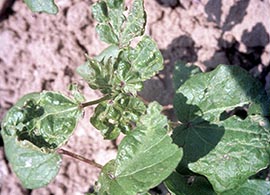
Photo by Marlin Rice
Frankliniella fusca, or tobacco thrips, is the most common thrips species, though the western flower thrips (Frankliniella occidentalis) is more damaging.
Thrips in immature stages – the word “thrips” is used to refer both to one or many thrips -- are yellow or orange. Adult tobacco thrips are dark brown or black, while flower thrips are yellowish-brown to brown. Immature flower thrips are lighter in color and appear almost white.
The entire thrips life cycle can run, from egg to adult, 12 to 20 or 40 days, depending on temperatures. Tobacco thrips have a shorter average life cycle of about two weeks. Female thrips will lay from 45 to 60 eggs. These eggs hatch within seven days or less in warm weather.

Thrips damage seedling plants most severely, mainly affecting cotton but also soybeans. They injure the plants by feeding on the emerging leaves that are barely visible in the first true leaves above the cotyledons. Though the leaves do not show immediate damage, they are deformed and have wrinkled surfaces when the first true leaves unfold.
These deformed leaves can delay cotton maturity by two weeks and result in serious yield reductions of 100–200 pounds of lint per acre.
To scout for thrips, use a cigar box or a clipboard with a sheet of white paper in or on it. With a forceful swing of the hand, slap four or five cotton or bean seedlings onto the white paper. Use one forceful slap — any more will reduce the reading.
Look down at the paper for a minute or more. Those elongated specks of dirt, pointed on the rear end and moving, are thrips. Adults are dark; immatures are light. If there are immatures present, there is breeding in the field. The best cure would be to use a seed treatment to prevent damage. After-planting sprays are not as effective but necessary if thrips are in six of 10 locations that have been checked.
Keep in mind that thrips damage and wind damage look similar. Always check seedling cotton for thrips until there are four leaves above the cotyledons.
